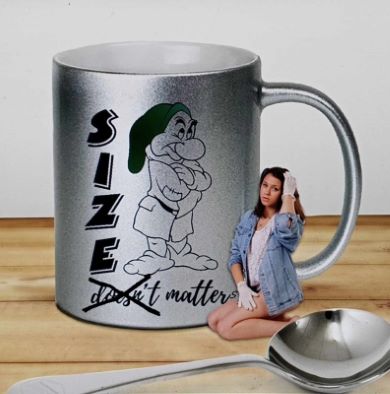https://www.msn.com/en-us/news/technolo ... 165f&ei=33
Article posits a theory that evolution seems to trend towards a species becoming for several reasons such as staying closer to preferred habitats and require less energy.
Just throwing this out there for the usual "size talk in the real world" stuff here, but it also gave me the seed for an idea involving accidental rapid evolution creating SWs.
Evolutionary Theory Explains Shrinking Animals
-
rscholar

- Shrink Master

- Posts: 296
- Joined: Thu Feb 01, 2018 11:27 pm
-
DocRick

- Shrink Grand Master

- Posts: 4303
- Joined: Fri Feb 24, 2023 2:53 am
- Location: The Dark Side
- Gender:
Re: Evolutionary Theory Explains Shrinking Animals
In theory, yes it could happen. I saw a show on NOVA about an extinct race of three foot tall human skeletal remains found on an island in Indonesia. Why they died out is unknown, but it could be a variety of reasons from temperature to resource availability. But molecular size doesn't change, so getting much smaller would probably result in a "human" that doesn't really look like modern humans and unless they evolved to use much more of their brain than we do, they would have the intelligence of mice. Look at primates. The Great Apes are much more intelligent than say chimpanzees. I can imagine as small as two foot tall humans evolving given just the right circumstances but my favorite size of 5 inches, not so very likely.
-
ensmallen
- Shrink Master

- Posts: 457
- Joined: Thu Jan 23, 2020 12:45 am
- Gender:
Re: Evolutionary Theory Explains Shrinking Animals
Along a similar science-y theme, this just showed up on my feed. Obviously a stretch but, squinting really hard...
https://www.youtube.com/watch?v=RfYW4xTiSAw
https://www.youtube.com/watch?v=RfYW4xTiSAw
SpoilerShow
Oct 23, 2018
From “Fantastic Voyage” to “Despicable Me,” shrink rays have been a science-fiction staple on screen. Now chemists at The University of Texas at Austin have developed a real shrink ray that can change the size and shape of a block of gel-like material while human or bacterial cells grow on it. This new tool holds promise for biomedical researchers, including those seeking to shed light on how to grow replacement tissues and organs for implants.
The shrink ray is a near-infrared laser that can be focused onto tiny points inside the substrate. The substrate looks and behaves a bit like a block of Jell-O. On the microscopic level, it’s made of proteins jumbled and intertwined like a pile of yarn. When the laser strikes a point within the substrate, new chemical bonds are formed between the proteins, drawing them in more tightly, a change that also alters the surface shape as it’s tugged on from below. Researchers scan the laser through a series of points within the substrate to create any desired surface contour at any place in relation to targeted cells.
Unlike other methods for altering the substrate under living cells, the UT Austin shrink ray doesn’t heat or chemically alter the surface, damage living cells or cause cells to unstick from the surface. And it allows the formation of any 3D pattern on demand while viewing the growing cells through a microscope.
https://news.utexas.edu/2018/10/23/hone ... l-culture/
From “Fantastic Voyage” to “Despicable Me,” shrink rays have been a science-fiction staple on screen. Now chemists at The University of Texas at Austin have developed a real shrink ray that can change the size and shape of a block of gel-like material while human or bacterial cells grow on it. This new tool holds promise for biomedical researchers, including those seeking to shed light on how to grow replacement tissues and organs for implants.
The shrink ray is a near-infrared laser that can be focused onto tiny points inside the substrate. The substrate looks and behaves a bit like a block of Jell-O. On the microscopic level, it’s made of proteins jumbled and intertwined like a pile of yarn. When the laser strikes a point within the substrate, new chemical bonds are formed between the proteins, drawing them in more tightly, a change that also alters the surface shape as it’s tugged on from below. Researchers scan the laser through a series of points within the substrate to create any desired surface contour at any place in relation to targeted cells.
Unlike other methods for altering the substrate under living cells, the UT Austin shrink ray doesn’t heat or chemically alter the surface, damage living cells or cause cells to unstick from the surface. And it allows the formation of any 3D pattern on demand while viewing the growing cells through a microscope.
https://news.utexas.edu/2018/10/23/hone ... l-culture/
-
Prof Sai

- Shrink Grand Master

- Posts: 1883
- Joined: Sat Jan 27, 2018 11:27 pm
- Gender:
Re: Evolutionary Theory Explains Shrinking Animals
Sperm whales have a brain that is five times the size of a human's brain, so intelligence doesn't necessarily track. Looking exactly human isn't as important. Maybe they are cute elves or hobbits.DocRick wrote: ↑Mon Jul 22, 2024 11:20 amBut molecular size doesn't change, so getting much smaller would probably result in a "human" that doesn't really look like modern humans and unless they evolved to use much more of their brain than we do, they would have the intelligence of mice. Look at primates. The Great Apes are much more intelligent than say chimpanzees. I can imagine as small as two foot tall humans evolving given just the right circumstances but my favorite size of 5 inches, not so very likely.
-
DocRick

- Shrink Grand Master

- Posts: 4303
- Joined: Fri Feb 24, 2023 2:53 am
- Location: The Dark Side
- Gender:
Re: Evolutionary Theory Explains Shrinking Animals
Whales aren't primates. They are a thousand times larger but their brain is only five times larger. They are intelligent, but different because of their environmental conditions resulted in different evolution. Apples to oranges. Elves and hobbits are cute, but I think most members of the forum prefer actual tiny humans over humanoids.Prof Sai wrote: ↑Tue Jul 23, 2024 7:32 amSperm whales have a brain that is five times the size of a human's brain, so intelligence doesn't necessarily track. Looking exactly human isn't as important. Maybe they are cute elves or hobbits.DocRick wrote: ↑Mon Jul 22, 2024 11:20 amBut molecular size doesn't change, so getting much smaller would probably result in a "human" that doesn't really look like modern humans and unless they evolved to use much more of their brain than we do, they would have the intelligence of mice. Look at primates. The Great Apes are much more intelligent than say chimpanzees. I can imagine as small as two foot tall humans evolving given just the right circumstances but my favorite size of 5 inches, not so very likely.
-
DocRick

- Shrink Grand Master

- Posts: 4303
- Joined: Fri Feb 24, 2023 2:53 am
- Location: The Dark Side
- Gender:
Re: Evolutionary Theory Explains Shrinking Animals
Another issue would be food, water and even air. If the tiny was shrunken, even their cells being shrunken, would they be able to use the 12 times larger molecules of food, water and air? In an LOTG scenario, would the giant world be made of giant cells or just cells made of 12 times the number of cells? The tiniest animals of our world, mice and moles and such, are made of the same cells as us, just a much smaller number, so if tiny by evolution, like borrowers or Lilliputians, it could be possible.
-
Prof Sai

- Shrink Grand Master

- Posts: 1883
- Joined: Sat Jan 27, 2018 11:27 pm
- Gender:
Re: Evolutionary Theory Explains Shrinking Animals
The point was that brain size does not equal intelligence. If there is a reason for whales, then their could just as easily be a reason for elves.
I don't like humans. Former humans shrunk to elf/hobbit size is interesting though. Maybe do a poll?
-
I am Nobody
- Shrink Aprentice

- Posts: 42
- Joined: Thu Jul 21, 2022 8:48 am
Re: Evolutionary Theory Explains Shrinking Animals
Um, Chimps are great apes and one of the most intelligent of the great apes. Orangutans, another great ape are a bit smarter but not as closely related to humans as chimps and bonobos. In the primate family there are old and new world monkeys, lesser apes like gibbons, great apes chimpanzees, bonobos, orangutans and gorillas, hominids which are basically a souped up great ape like neanderthals, Homo habilis, Homo erectus, and finally Homo Sapiens. Imagine Butt Head saying, "He said homo." Also the smallest known humans that look human are pygmies about to 3 to 4 feet tall. Sorry, had to get that in.